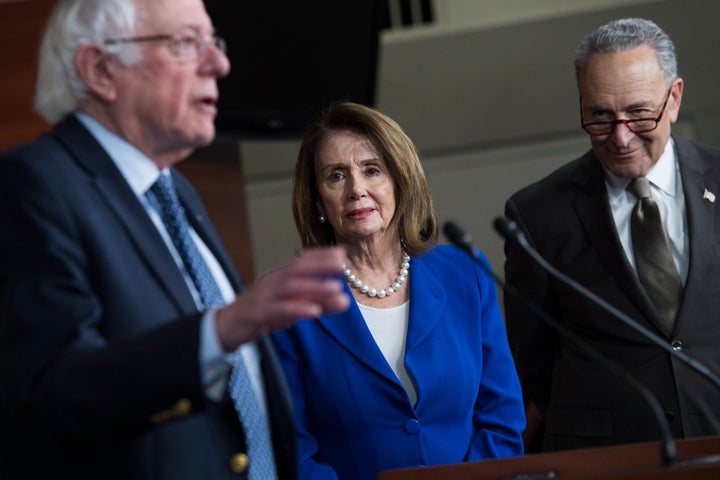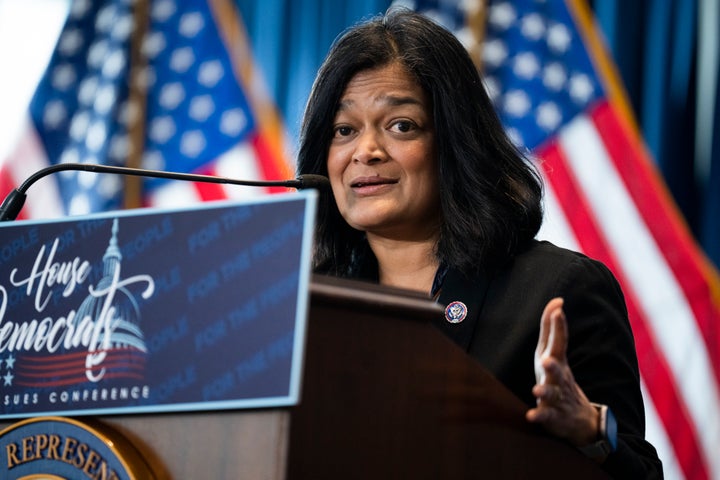If you want to understand why Democrats and their allies are so excited about the prescription drug reforms that President Joe Biden signed on Tuesday, it helps to think about how long they have been trying to put those reforms on the books.
The idea of giving the federal government leverage over pharmaceutical prices goes back decades, at least to the early 1990s when former President Bill Clinton was putting together his ill-fated plan for universal health care. He remembered the stories he had heard on the campaign trail, about average Americans struggling with the costs of medications for conditions like diabetes, high blood pressure or multiple sclerosis, and at one point advisers contemplated a freeze on prices to provide quick, temporary relief.
The Clinton team settled instead on some other proposals, including one that would give the federal government power to negotiate prices directly with pharmaceutical companies, who were predictably unhappy about it. Their lobbying against the Clinton plan contributed to its eventual demise, cementing the impression that the drug industry would never lose a big fight over their pricing practices.
Except now it has happened.
A key provision of the Inflation Reduction Act, which is the law Biden signed this week, gives the secretary of health and human services authority to negotiate the price of drugs in the Medicare program. And Democrats were able to pass it despite an onslaught from an industry that, according to OpenSecrets.org, spent $187 million on lobbying this year alone.

Tom Williams via Getty Images
“Pharma did not lay down their weapons in this fight,” Larry Levitt, executive vice president at the Henry J. Kaiser Foundation, told HuffPost. “This was unquestionably the biggest political loss Pharma has suffered.”
The defeat was far from total, with industry allies inside the Democratic caucus winning concessions that significantly reduced the program’s reach. Only a small number of drugs will be subject to price negotiation, and even then only within certain parameters that will almost certainly leave prices in the U.S. higher than they are overseas. The first negotiated prices will not take effect until 2026 and the drug industry may yet find a way to weaken the program even more, through litigation, legislation or both.
But other drug price reforms will kick in a little sooner, with more visible effects. High on that list is a new, $2,000 limit on out-of-pocket expenses for Medicare beneficiaries that will phase in over two years, starting in 2024. As for the negotiating power, future lawmakers could dial it up just as surely as they could dial it down. That possibility, as much as any immediate, real-world effects, is what the industry fought so hard to prevent and what advocates fought so hard to preserve.
“Sometimes it seems like Congress creates policy overnight, but in fact these plans are typically years, if not decades, in the making.”
– Larry Levitt, Henry J. Kaiser Family Foundation
“This is a seismic shift,” Sen. Ron Wyden (D-Ore.) told HuffPost. “For the first time, the scales are shifted and Big Pharma is going to have to do what everybody else on the planet does, which is to negotiate.”
Of course, Wyden and everyone else who supported the bill have another reason to feel good about the legislation. They understand what it took to get this far. If there’s an untold story about the new prescription drug reforms ― or, at least, an under-appreciated one ― it’s about how much of the work took place before Democrats gained full control of Congress and Biden came to the White House.
House Democrats Got To Work Quickly
One reason the federal government hasn’t directly negotiated drug prices until now is that it literally would have been against the law.
When Republican lawmakers wrote the 2003 statute creating a drug benefit in Medicare, they included a clause prohibiting the federal government from meddling with prices. Democrats were livid (as were a handful of Republicans) and said that striking the prohibition would be a top priority going forward.
But Democrats didn’t pursue that goal in 2009 and 2010, when they had full control of Congress and Barack Obama was in the White House, because they were focused on passing what became the Affordable Care Act. As part of a deal to keep the drug companies from doing to “Obamacare” what industry lobbyists had once done to “Clintoncare,” the White House and Democratic leaders agreed not to make government negotiation of prices part of the new scheme.
Obama circled back to the idea later in his presidency, but he never got the chance to make it happen. The same thing was true for Hillary Clinton, who not only made government price negotiation a key campaign promise in 2016 but also had lengthy conversations with experts and advocates over how to draw up legislation.

Drew Angerer via Getty Images
“The plan from Clintonland was to go after pharma right away — it was a done deal,” Alex Lawson, executive director of the progressive advocacy group Social Security Works, told HuffPost. “We were talking about big ideas, executive actions, that she could take right away, and then there was going to be legislation too.”
All of that set the stage for the 2018 midterm campaign, when Democrats sensed an opportunity to win back control of the House for the first time in nearly a decade.
Progressive groups like Social Security Works and Public Citizen were pushing hard for strong prescription drug reforms, as were organizations more focused on health care like FamiliesUSA and Patients for Affordable Drugs Now. And they had a receptive audience in Democratic leadership, especially House Speaker Nancy Pelosi (D-Calif.), who saw it as her top piece of unfinished business from the last time Democrats controlled the chamber.
“We made a lot of headway in the last Congress. At least 50% of the final bill came from there.”
– Senate Finance Chairman Ron Wyden
House Democrats got to work on legislation quickly after taking control of the chamber in early 2019. But it wasn’t easy. The policy choices they faced created some serious rifts, frequently pitting progressives like Lloyd Doggett of Texas against centrist counterparts like Scott Peters of California. Among the arguments were questions of which drugs should be subject to negotiation — and exactly how the negotiation process should work.
At several points, tensions spilled out into public view, with one side or the other threatening to withhold its votes and tank the whole effort. But it never came to that and, in December of 2019, the House passed H.R. 3, the Elijah E. Cummings Lower Drug Costs Now Act, named for the longtime Maryland lawmaker (and close Pelosi ally) who had crusaded for lower drug prices before his death.
Getting A CBO Score Was A Key Step
The passage of H.R.3 didn’t get a ton of attention, partly because something else was happening in Washington at the time. Just two days earlier, House Democrats had issued their articles of impeachment against then-President Donald Trump.
There was also the fact that the House bill stood almost no chance of becoming law. Republicans still controlled the Senate, and Republican leaders had said repeatedly they wouldn’t take up the legislation. Trump, despite frequent talk of getting tough with drugmakers, had finally announced that he, too, opposed the House bill.
But the exercise of passing legislation forced Democrats to translate their goals and slogans into policy specifics, which meant dealing with a variety of technical issues and making some difficult political choices. “Sometimes it seems like Congress creates policy overnight, but in fact these plans are typically years, if not decades, in the making,” Levitt said. “Doing the groundwork, like Speaker Pelosi did with H.R. 3, puts you in a position to act quickly when the political stars align.”

Tom Williams via Getty Images
A particularly critical step in the Democratic drug pricing effort was agreeing on a mechanism to get drugmakers to accept negotiated prices, and then getting the Congressional Budget Office to certify that the mechanism would produce real savings. The latter was a major focus for Pelosi’s office throughout 2019.
“When my teams sat down to do this, the inside team and the outside team, we vowed that, when we’re done, we’re going to have a CBO score that was substantial — that we’re going to have outside validation that negotiation really produced savings,” Wendell Primus, Pelosi’s senior adviser on health care issues, told HuffPost.
They fulfilled that vow: When Democrats eventually settled on a tax penalty for drugmakers that refused to negotiate, the CBO concluded the resulting price drop would save the federal government more than $450 billion over 10 years. And as contentious as the debates over legislation got at times, they forced the party’s factions to work through their differences and get behind a set of reforms they could all support.
“It was a knock-down, drag-out fight … I have the scars to show from it,” said Lawson, who along with other progressives pushed for more expansive negotiating authority, as well as the ability to threaten patents when drug prices were out of control.
“But I think that what it yielded in H.R. 3 was a very strong compromise bill that got both the right of the caucus and the left of the caucus on board, and the outside groups too,” Lawson said.
Thinking ahead to how that legislation prepared Democrats for what they did in 2021 and 2022, Lawson said, “The tracks were laid down.”
Senate Democrats Used The Leverage They Had
Democrats in the Senate were also eager to do something on drugs. And they had a forum in the Finance Committee, where the ranking Democrat, Ron Wyden of Oregon, had a good working relationship with the Republican chair, Charles Grassley of Iowa.
Wyden was a longtime advocate for seniors’ health care, going back to the 1970s and his tenure as a leader in the Gray Panthers. Grassley had frequently criticized the drug industry for what he thought was price gouging. They worked together on a bipartisan bill that they hoped Trump would support, given his frequent jabs at the industry, and that GOP leaders would eventually allow onto the floor.
It didn’t happen, but, as in the House, the exercise of writing the bill gave Democrats a chance to work through the details of some key policy concepts — among them, penalties for companies that raised their prices faster than inflation. That provision became a cornerstone of a proposal Wyden released in 2021, after Biden took office.
“We made a lot of headway in the last Congress,” Wyden said last week, thinking about the inflation penalty scheme and its origins. “At least 50% of the final bill came from there.”
Wyden’s 2021 announcement was another one of those developments that got a lot of eye-rolling in Washington. But many advocates saw it as both a blueprint for legislation and an indication that Democrats were serious about reform — a signal that seemed especially poignant coming from the Finance Committee, which was notorious for its past hostility to more expansive health reforms.
“The money committees, that’s where good ideas go to die,” Lawson said. “But when Wyden put out his road map, it was really strong. … He was really out front on trying to do something real on drug prices.”
Eliot Fishman, senior director of health policy at FamiliesUSA, told HuffPost the Wyden road map was “a huge step.”
“Remember,” Fishman said, “there was still doubt in the spring of 2021 if prescription drugs was going to sink the package, and Wyden solidified the Senate at a key moment.”
It Was Still On Biden And Allies To Get The Job Done
As important as all of the groundwork was, it merely meant that Democrats in 2021 had an opportunity to pass prescription drug reform. It still took a herculean effort, by the White House and leaders in both houses of Congress, as well as the advocacy groups that had been pushing the concept for so many years.
They had a few things going for them, starting with the widespread support for their agenda: Government price negotiation is popular even with Republican-leading voters, according to polls, and is likely a big reason so many moderate Democratic lawmakers were pushing for it as strongly as some progressives. It also helped that aggressive action on prescription drugs would lead to less federal spending, freeing up funds for other Democratic priorities or reducing the deficit.
“It was a knock-down, drag-out fight … I have the scars to show from it.”
– Alex Lawson, Social Security Works
“It would have been policy and political malpractice not to take advantage of the moment,” consultant and longtime Democratic health care adviser Chris Jennings told HuffPost.
But with razor-thin Democratic majorities in both houses, Sen. Kyrsten Sinema of Arizona and other industry allies wary of aggressive reforms had extra leverage. The result was more tension, multiple hold-your-breath moments and eventually a series of major compromises on the scope of negotiating power that disappointed and sometimes infuriated the measure’s progressive champions.
Among them was Sen. Bernie Sanders (I-Vt.), who called the final agreement “weak,” and Rep. Pramila Jayapal (D-Wash.), who told The American Prospect this week she still has “heartburn” over deals that will delay benefits or make them invisible to so many Americans.
But Sanders voted yes on the final bill. Jayapal did too, saying she was “incredibly proud” of the role progressives played in its passage even as she intended to “remain vigilant” and keep pushing for more. It’s the same promise that Wyden made, and Pelosi too — really, pretty much every Democrat and every ally who worked to make the prescription drug reforms a reality.
None thought it sufficient. Nearly all thought it was a big step forward, on the theory — and, yes, the hope — that it won’t be the last.

